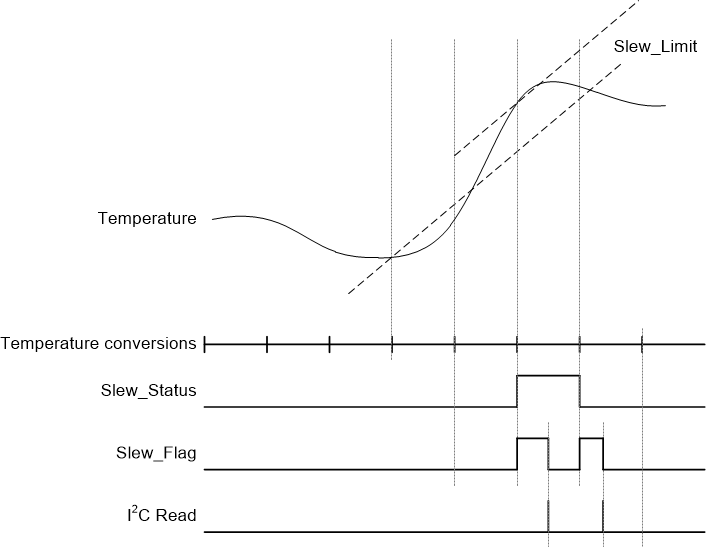SNIS214E june 2021 – july 2023 TMP114
PRODUCTION DATA
- 1
- 1 Features
- 2 Applications
- 3 Description
- 4 Revision History
- 5 Device Comparison
- 6 Pin Configuration and Functions
- 7 Specifications
- 8 Detailed Description
- 9 Application and Implementation
- 10Device and Documentation Support
- 11Mechanical, Packaging, and Orderable Information
Package Options
Refer to the PDF data sheet for device specific package drawings
Mechanical Data (Package|Pins)
- YMT|4
Thermal pad, mechanical data (Package|Pins)
Orderable Information
8.3.4 Slew Rate Warning
The slew warning alert is an alert option that can be adjusted with the Slew_Limit register. The slew rate warning will notify the system of rapid temperature changes as they occur, allowing the system to react and correct for the increase in temperature before reaching thermal operating limits. Compared to throttling a system after crossing a thermal limit, the slew rate warning will allow more safe system operation and greater reliability by not exceeding specified system operating conditions.
 Figure 8-2 Slew Rate Alert
Figure 8-2 Slew Rate AlertCalculating the slew rate requires a fixed time period to calculate and is only available in continuous mode. The Slew_Limit register is used to set the unsigned limit. The TMP114 will monitor the temperature slew rate and compare the positive change of temperature from the current conversion to the previous against the Slew_Limit. If the slew rate exceeds the Slew_Limit, the respective bits in the Alert_Status register will be set to indicate the warning. Figure 8-2 depicts the timing of the Slew Rate Warning relative to the temperature conversions. The slew rate check is always applied to the current temperature conversion and the previous temperature conversion.
 Figure 8-3 Slew Rate Warning Timing Diagram
Figure 8-3 Slew Rate Warning Timing DiagramThe accuracy of the slew rate alert is ±15 % due to the dependence on the internal oscillator frequency variation for the calculation. Upon exiting continuous conversion mode, the slew rate alert will be automatically shut off. The register settings will not be altered. The feature will automatically turn on upon entering continuous conversion mode. The slew rate alert can only be set for positive slew rate limits.